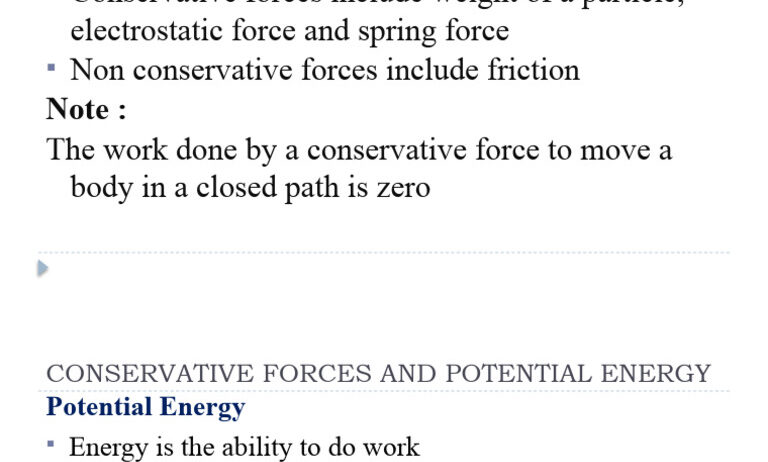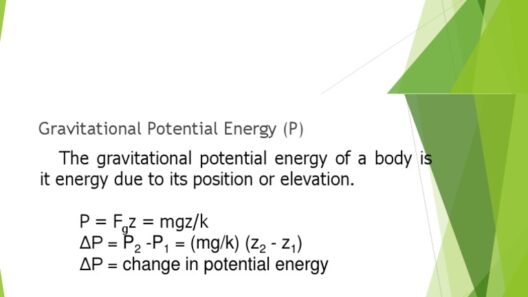Conservative energy systems are foundational in understanding mechanical and potential energy in physics. These systems possess the characteristic that the work done by the forces within these systems is independent of the path taken. This principle begs a crucial question: does the path matter in conservative energy systems? The exploration of this query involves examining the nature of conservative forces, the significance of potential energy, and the implications for the broader framework of energy conservation.
To start, one must delineate the concept of conservative forces. A conservative force is a force in which the work done is path-independent. This means that the work done by the force when moving an object from point A to point B is always the same, regardless of the trajectory taken between those two points. A quintessential example of a conservative force is gravitational force. When an object is lifted against gravity, the work done depends solely on the height difference between the initial and final points, not how it was moved (horizontally or vertically).
In contrast, non-conservative forces, such as friction and air resistance, do care about the path taken. These forces consume energy, often converting it into other forms, usually heat, which dissipates into the environment. This inherent distinction highlights a core aspect of energy conservation and efficiency. Understanding whether the path matters in a conservative system requires probing deeper into the concepts of work and energy.
When analyzing conservative systems, the concept of potential energy emerges as a key player. Potential energy, represented in various forms such as gravitational potential energy or elastic potential energy, is a stored form of energy dependent on an object’s position in a force field. The foundational principle asserts that as an object moves within a conservative force field, its total mechanical energy—comprised of kinetic and potential energy—remains constant. This conservation law implies that potential energy can be converted to kinetic energy and vice versa, maintaining the total energy of the system.
One of the most illustrative examples of this principle can be seen in pendulum motion. The pendulum exemplifies a conservative system where potential energy is at its peak at the highest points in its swing and kinetic energy reaches its maximum at the lowest point. Regardless of how the pendulum is released or the specific trajectory it takes to reach its lowest point, the total mechanical energy of the pendulum remains constant throughout the motion. This clearly demonstrates that in conservative systems, the path taken does not alter the energy transformation occurring within the system.
Another significant aspect to consider is how path independence influences practical applications. Engineers and scientists often harness conservative forces in designing mechanisms such as roller coasters and hydraulic lifts. In these systems, understanding the conservation of energy allows for the efficient design of energy transfers, ensuring that energy loss is minimized while maximizing safety and depending excessively on gravitational potential energy. The reliability of these systems is fortified by their inherent properties, allowing designers to create effective solutions based on established physical laws.
Moreover, the role of mathematical representation comes into play when discussing path independence. The potential energy associated with conservative forces can typically be expressed as a scalar function of position, often referred to as a “potential function.” This representation allows for the calculation of work done by conservative forces as an integral of the force field over a specific path. However, due to the independence of the path in conservative systems, this integral can frequently be simplified. This characteristic dramatically simplifies calculations in physics, allowing for straightforward predictions and analyses.
Yet, it is crucial to note that while the principle of path independence holds true in ideal conditions, real-world scenarios often introduce complexities. Factors such as dissipative forces, varying mass, or non-linear trajectories can influence energy conservation. In practical scenarios, the analysis may require adjusting an ideal conservative model to incorporate these non-ideal conditions. Understanding these nuances is vital for applying theoretical principles to tangible situations, ensuring a comprehensive grasp of energy dynamics in the real world.
Furthermore, exploring the implications of path independence extends beyond mechanics. In thermodynamics, for example, several systems exhibit conservative-like behavior under specific conditions. The analysis of state functions, which are properties dependent solely on the state of the system, rather than the path taken to reach that state, can parallel discussions in conservative mechanics. This interconnectedness among disciplines reveals broader implications for energy conservation and utilization across various fields, highlighting the universal importance of understanding these principles.
In conclusion, while the path taken within conservative energy systems does not fundamentally alter the work done or energy transformations occurring, it provides a rich context for analyzing energy dynamics. By showcasing the role of conservative forces, potential energy, and practical applications, the exploration of this topic emphasizes the significance of conservation principles in both theoretical physics and real-world systems. Moreover, recognizing the potential complexities when transitioning from ideal models to practical applications underscores the importance of a nuanced understanding of these concepts, ensuring a holistic view of energy conservation and its relevance in diverse fields.






